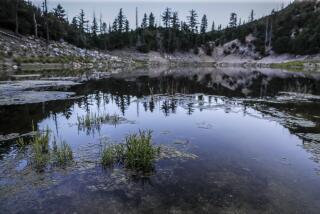San Gabriel Valley homeowners swarm to meeting about citrus disease
Area homeowners are responding to agricultural officials’ call to action to help save the state’s $2-billion citrus industry and their beloved backyard trees from a bacterium that the Citrus Research Board has referred to as “a death sentence for California citrus.”
About 100 worried homeowners buzzed with questions during an information session last week in the San Gabriel Valley. State agricultural inspectors have enacted a quarantine in a five-mile radius around the neighborhood where Huanglongbing, or yellow dragon disease, was first confirmed March 30 in a citrus tree in Hacienda Heights.
“It turns out I’m barely inside the quarantine boundary; I wanted to know whether I can continue to give out my fruit or not,” said Don Winterstein, resident of Brea and longtime member of California Rare Fruit Growers. “Their answer was ‘no way’ … but I can’t object to that. It’s a very serious problem. I just hope they do what’s necessary to get rid of this thing.”
There is no known cure for HLB, which attacks a tree’s vascular system, causing misshapen, bitter fruit before killing the tree. It is carried by the Asian citrus psyllid, a gnat-size flying pest that first appeared on domestic fruit trees in California in 2008.
Inspectors have gone door-to-door collecting samples of the pest within a half-mile radius of the diseased tree. None have tested positive, state officials say, and the tree was removed Thursday and sent to a state lab for analysis and disposal. Citrus trees within this area will be sprayed with psyllid pesticides beginning this week, and inspectors will continue to monitor and routinely survey the area.
“What we really need is the assistance of the residents,” said Los Angeles County Agricultural Commissioner Kurt E. Floren. “They grow their own fruit, they share buds amongst themselves … and that can be a primary means of transferring the disease.”
Floren, who said the quarantine will probably hold for at least two years, said similar information sessions for other eradication programs have had turnouts as small as eight people for the entire evening.
The community has been particularly responsive to HLB, wondering how to help prevent the spread of psyllids to other areas.
“I just don’t want to see what happened in Florida happen here. Especially if it’s because we moved too slow,” said Jenifer Chungafung, a physician from Rowland Heights. “I have citrus trees, and my friend has a business up north. That would be his whole livelihood.”
There are more than 285,000 acres of commercial citrus groves across California, the nation’s second-largest citrus grower, behind Florida. HLB has wreaked havoc on the citrus industries in Florida and Brazil.
“It’s nice they gave us these pictures,” said Hacienda Heights resident Diane Kakimi, holding fliers with enlarged images of the pests and a hotline number. Kakimi has tended her four citrus trees for more than 20 years and planned to go home to inform her neighbors.
“I’m going back and taking a good careful look at my trees and the leaves,” she said.
Those who believe they have spotted symptoms of HLB in local citrus trees are asked to call the California Department of Food and Agriculture’s pest hotline, (800) 491-1899.
More to Read
Start your day right
Sign up for Essential California for news, features and recommendations from the L.A. Times and beyond in your inbox six days a week.
You may occasionally receive promotional content from the Los Angeles Times.







